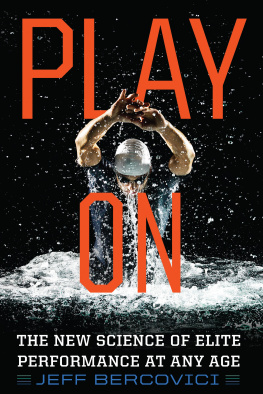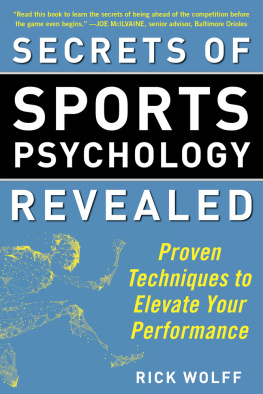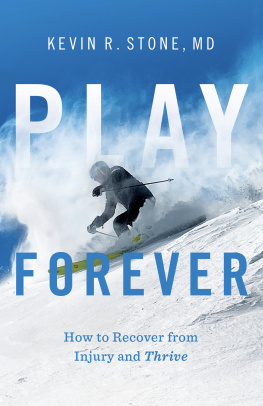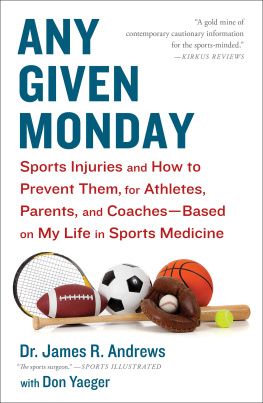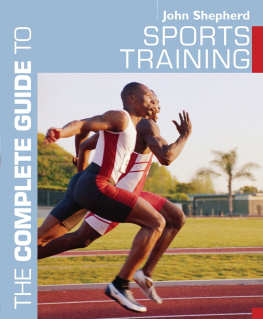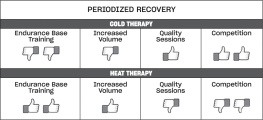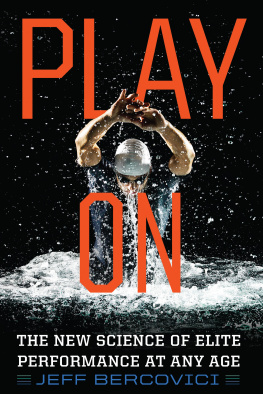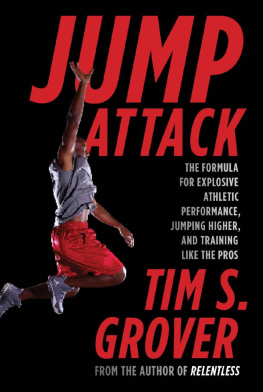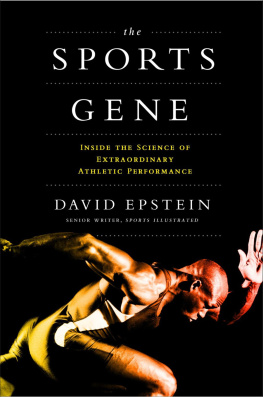Copyright 2018 by Jeff Bercovici
All rights reserved
For information about permission to reproduce selections from this book, write to or to Permissions, Houghton Mifflin Harcourt Publishing Company, 3 Park Avenue, 19th Floor, New York, New York 10016.
hmhco.com
Library of Congress Cataloging-in-Publication Data
Names: Bercovici, Jeff, author.
Title: Play on : the new science of elite performance at any age / Jeff Bercovici.
Description: Boston : Houghton Mifflin Harcourt, 2018. | Includes bibliographical references and index.
Identifiers: LCCN 2017061532 (print) | LCCN 2017050323 (ebook) | ISBN 9780544935327 (ebook) | ISBN 9780544809987 (hardback)
Subjects: LCSH : Physical fitness for older people | Sports for older people.
| Exercise for older people. | AgingPhysiological aspects. | Sports sciences. | BISAC: SCIENCE / Life Sciences / Anatomy & Physiology (see also Life Sciences / Human Anatomy & Physiology).
Classification: LCC GV 482.6 (print) | LCC GV 482.6 . B 47 2018 (ebook) | DDC 613.7/0446dc23
LC record available at https://lccn.loc.gov/2017061532
Cover design by Martha Kennedy
Cover photograph Henrik Sorensen/Getty Images
Author photograph Tony Conrad
v1.0418
For Robyn
You were always the jock in the family
Introduction
Overtime Starts Now
Im halfway through the most grueling four minutes of my life, wondering how Im going to survive the next 120 seconds, when my tormentor, a deceptively personable southerner named Joel, breaks into my suffering with what I assume to be a stupid joke. My assumption is wrong, but it will be another two minutes before I realize that.
Not to psych you out or anything, Joel says, but a bunch of coyotes are watching you.
Hilarious, I manage to croak, and go back to watching the numbers on the digital readout in front of my face crawl upward.
Why shouldnt there be coyotes watching me, though? Theyre a common-enough sight, prowling for rabbits and the occasional unwary house cat, here on the dusty outskirts of Phoenix, Arizona. I can imagine what they would see: a 38-year-old man, shortish of stature and slight of build, hanging by all four limbs from a black steel apparatus, grimacing and wheezing like hes on the brink of multisystem organ failure. An easy if stringy meal for a pack of scavengers, once they peel off the sweaty sausage-casing of compression apparel.
Granted, this particular spot is an unlikely venue for a wild-animal attack. Im in a 31,000-square-foot, $10 million state-of-the-art training and wellness facility operated by a company called Exos. Formerly known as Athletes Performance, Exos owns a chain of these clinics, scattered mostly across the Sun Belt, in cities like Los Angeles, Atlanta, San Diego, Dallas, and Pensacola. Its locations correspond roughly to the regions where professional athletes spend their increasingly brief off-seasons. This facility is the flagship.
Although its clients include large corporations and the U.S. military, Exos is best known for getting some of the worlds strongest and fastest people in peak shape before their competitive seasons begin. On this July day, the campus is hosting a contingent of 30 or so NFL players, here to put a scalpel edge on their fitness before reporting to their teams respective training camps in three weeks time. This being Phoenix, they had to get their outdoor work out of the way early, before the temperature broke triple digits. At seven this morning, notebook in hand, I watched from a minimum safe distance as LeSean McCoy of the Buffalo Bills, Cameron Jordan of the New Orleans Saints, Prince Amukamara of the New York Giants, Colin Kaepernick of the San Francisco 49ers, and other genetically blessed multimillionaires performed football-specific fitness drillssprinting between different-colored cones while Brett Bartholomew, Exoss lead NFL trainer, called out directions; accelerating laterally from a standstill while being dragged in the other direction by bungee cords; and so on. The players were clearly working hard, but it was a different sort of hard work than the kind you see dramatized in those Gatorade and Nike commercials. There were no faces contorted in agony or voices screaming out Give me one more! The emphasis was on detail, not all-out exertion. Afterward, Bartholomew explained that getting players ready for a season doesnt have much to do with the stuff they obsess about at the combine40-yard-dash times, bench-press repetitions, that kind of thing. With actual veterans, its about taking care of their bodies and doing everything the right way, he says.
Now its midday and the torrid desert sun is directly overhead: 108F and 9 percent humidity. The players were sent home hours ago with orders from Bartholomew to spend the afternoon taking a nap, lying in a whirlpool, doing yoga, playing video gamesanything but exercising more. Remember, our muscles have currency just like our bank accounts, he admonished them before dismissing them to the cafeteria to pick up their personalized recovery smoothies, each one tailored to its drinkers body composition and sweat chemistry. (To make sure the athletes are drinking enough fluids, the bathrooms are decorated with posters, conveniently hung over the urinals, showing what pee looks like at different levels of hydration.) It seems like everyone has listened, except for Kaepernick, who proceeds to spend the next four hours in the facilitys airplane-hangar-sized weight room, chiseling new creases into his already famously buff, tattooed torso.
With nothing better to do, I sign up for a training session with Joel Sanders, a veteran strength and conditioning coach. A rangy, earnest 30-year-old from Savannah, Sanders focuses mostly on Exoss civilian clientele, like the Silicon Valley venture capitalist who, once a quarter, brings his favorite portfolio companies CEOs here for a long weekend of boot campstyle workouts, hot and cold pools, organic meals, and deep-tissue massages. Joining me for the session is Dan, a tall drink of water who turns out to be a recently graduated college basketball player staying in shape in hopes of getting a call from an injury-stricken NBA team in preseason.
At Joels instruction, we start by loosening up on foam rollers, seesawing back and forth over them to knead out our legs and backs. I take this opportunity to ask Joel the question on my mind: Whats the difference between me and Dan? Besides, obviously, the 10 inches in height and all the other inborn athletic traits that made him an NBA hopeful and me a natural-born journalist. No, what Im wondering about is the significance of the 16 years that separates us in age. Whats the difference, athletically speaking, between someone at 22 and that same person at 32 or 42 or 52?
Put your hand on your chest, Joel instructs me. I do so. Now, take your middle finger and tap your chest as hard as you can. I do that, too: tap, tap, tap. Keep your hand there. Joel reaches out, grabs my middle finger, pulls it back, and lets it go. Without me doing anything, it snaps back against my chest: THWAP!
The difference between tap and THWAP!, he says, is power. In physics terms, power is units of work divided by units of time. In laymans terms, its the ability to deliver force quickly. If you can lift a 100-pound dumbbell and carry it across the gym, youre strong. If you can pick it up and hurl it across the gym, youre strong and powerful. When you admire the explosive first step of a point guard, the 140-mile-per-hour serve of a tennis player, a running backs burst through the hole, a volleyball hitters thunderous spike, what youre admiring is power. More than anything else, its power, Joel says, that separates young athletes from old ones. Its what were here to work on.

